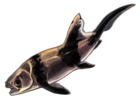Melanosteus
| Melanosteus | |
|---|---|

| |
| Artist's reconstruction | |
| Scientific classification | |
| Kingdom: | |
| Phylum: | Chordata
|
| Subphylum: | Vertebrata
|
| Class: | |
| Order: | |
| Suborder: | |
| Infraorder: | |
| Superfamily: | |
| Family: | |
| Genus: | Melanosteus
|
| Species: | M. occitanus
|
| Binomial name | |
| Melanosteus occitanus Lelièvre 1987
| |
Melanosteus occitanus is a small (skull about 5 centimeters long) selenosteid arthrodire placoderms known from the Upper Frasnian Montagne Noire of Southern France.[1] Rücklin (2011), regards M. occitanus as the sister taxon of Rhinosteus.[2] During the Frasnian, M. occitanus lived off the coast of an island continent, "Armorica," which consisted of portions of what would become Southern France.[3]
Etymology[]
The generic name literally translates as "black bone," the color referring to the translation of Montagne Noire, or "Black Mountains." The specific name refers to Occitania, the region of Southern France where the fossils were found.[1]
References[]
- ^ a b c LELIÉVRE, H.; FEIST, R.; GOUJET, D.; BLIECK, A. (1987). "Les vertébrés de la Montagne Noire (Sud de la France) et leur apport á la phylogénie des Pachyostéomorphes (Placodermes, Arthrodires)". Palaeovertebrata. 17: 1–16.
- ^ RÜCKLIN, MARTIN (January 14, 2011). "First selenosteid placoderms from the eastern Anti-Atlas of Morocco; osteology, phylogeny and palaeogeographical implications". Palaeontology. 56 (1): 25–62. doi:10.1111/j.1475-4983.2010.01026.x.
- ^ Long, John A. (1993). Palaeozoic vertebrate biostratigraphy and biogeography. 156: Johns Hopkins University Press, 1993. p. 369. ISBN 9780801847790.
{{cite book}}: CS1 maint: location (link)
Categories:
- Selenosteidae
- Placoderms of Europe
- Placoderm stubs


